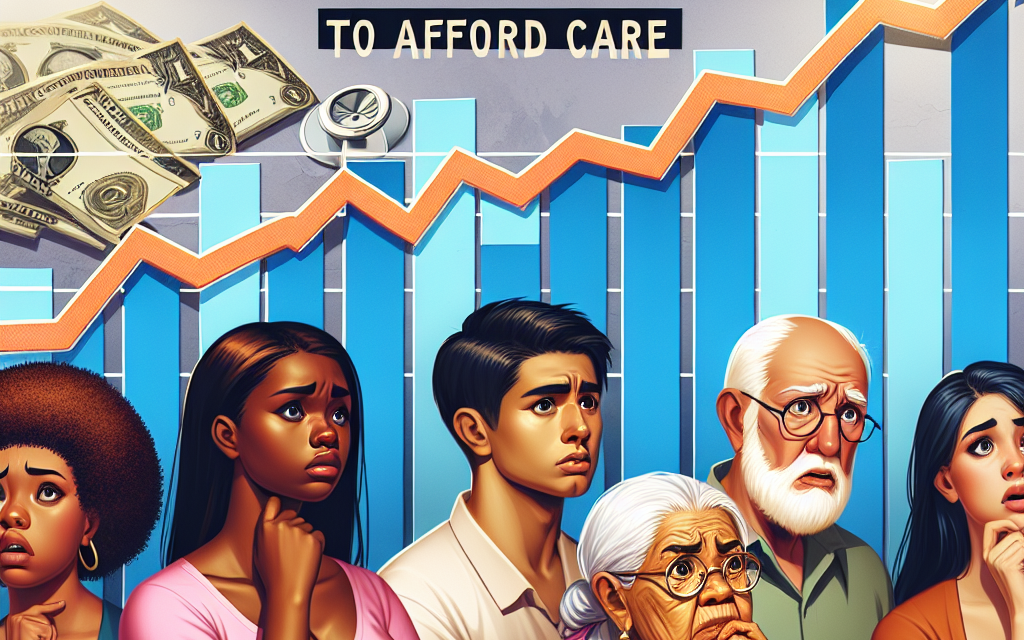Rising Healthcare Costs Leave More Americans Struggling to Afford Care: Gallup
The rising costs of healthcare in the United States have become a pressing issue, leaving many Americans grappling with the financial burden of medical expenses. According to a recent Gallup poll, a significant portion of the population is struggling to afford necessary care, leading to a myriad of consequences for individuals and families alike. This article delves into the multifaceted nature of rising healthcare costs, exploring the underlying factors, the impact on individuals, and potential solutions to this growing crisis.
Understanding the Current Landscape of Healthcare Costs
Healthcare costs in the United States have been on an upward trajectory for decades. The U.S. spends more on healthcare than any other country, with expenditures reaching approximately $4 trillion in 2020, which translates to about $12,500 per person. This section will explore the various components contributing to these rising costs.
The Components of Healthcare Spending
Healthcare spending can be broken down into several key components:
- Hospital Care: This includes inpatient and outpatient services, which account for a significant portion of healthcare spending. In 2020, hospital care represented nearly 32% of total healthcare expenditures.
- Physician Services: Payments to physicians for services rendered also contribute heavily to healthcare costs. This category has seen substantial growth due to increased demand for specialized care.
- Prescription Drugs: The cost of medications has skyrocketed, with prices for many essential drugs increasing dramatically over the past decade.
- Long-term Care: As the population ages, the demand for long-term care services has risen, further straining healthcare budgets.
- Administrative Costs: The complexity of the U.S. healthcare system leads to high administrative costs, which can account for up to 25% of total healthcare spending.
Understanding these components is crucial for grasping the overall picture of healthcare costs in America. Each element plays a role in the financial strain experienced by individuals and families.
Factors Driving Up Healthcare Costs
Several factors contribute to the rising costs of healthcare in the U.S., including:
- Technological Advancements: While innovations in medical technology can improve patient outcomes, they often come with high price tags that contribute to overall healthcare costs.
- Aging Population: As the baby boomer generation ages, the demand for healthcare services increases, leading to higher costs associated with chronic conditions and long-term care.
- Administrative Complexity: The fragmented nature of the U.S. healthcare system results in inefficiencies and high administrative costs, which are ultimately passed on to consumers.
- Market Consolidation: Mergers and acquisitions among healthcare providers can reduce competition, leading to higher prices for services.
- Pharmaceutical Pricing: The lack of price regulation in the pharmaceutical industry allows drug companies to set exorbitant prices for medications, further exacerbating the issue.
These factors create a perfect storm, driving up costs and leaving many Americans unable to afford necessary care.
The Impact on Americans’ Access to Care
The rising costs of healthcare have profound implications for access to care. Many Americans are forced to make difficult choices regarding their health and finances. This section will explore how these rising costs affect individuals and families across the country.
Financial Strain on Households
As healthcare costs continue to rise, many families find themselves facing significant financial strain. According to the Gallup poll, nearly 1 in 4 Americans reported that they or a family member had delayed or avoided medical care due to cost concerns. This delay can have serious consequences for health outcomes.
Some of the financial burdens faced by families include:
- High Deductibles: Many insurance plans come with high deductibles, meaning that individuals must pay a substantial amount out-of-pocket before their insurance kicks in.
- Unforeseen Medical Expenses: Unexpected medical emergencies can lead to significant financial hardship, especially for those without adequate insurance coverage.
- Prescription Drug Costs: The high cost of medications can lead individuals to skip doses or forgo necessary prescriptions altogether, jeopardizing their health.
- Medical Debt: Many Americans are forced to take on debt to cover medical expenses, leading to long-term financial instability.
- Impact on Savings: Rising healthcare costs can deplete savings, making it difficult for families to plan for the future or invest in other areas of their lives.
The financial strain caused by rising healthcare costs can lead to a cycle of poor health and financial instability, making it increasingly difficult for families to break free from this burden.
Health Outcomes and Quality of Life
The inability to afford necessary care can have dire consequences for health outcomes. Delaying or avoiding medical treatment can lead to worsening health conditions, increased hospitalizations, and even premature death. The Gallup poll highlights that those who struggle to afford care are more likely to report poor health status.
Some of the health outcomes associated with rising healthcare costs include:
- Increased Chronic Conditions: Individuals who cannot afford regular check-ups or medications may experience a worsening of chronic conditions such as diabetes or hypertension.
- Higher Rates of Emergency Room Visits: When individuals delay care, they may ultimately require more expensive emergency services, leading to higher overall costs.
- Mental Health Impacts: The stress of financial strain can lead to mental health issues, including anxiety and depression, further complicating health outcomes.
- Reduced Preventive Care: Many individuals forgo preventive services, such as vaccinations and screenings, which can lead to more severe health issues down the line.
- Lower Quality of Life: The inability to access necessary care can lead to a diminished quality of life, affecting not only physical health but also emotional and social well-being.
These health outcomes underscore the urgent need for solutions to address the rising costs of healthcare and improve access for all Americans.
Case Studies: Real-Life Impacts of Rising Healthcare Costs
To better understand the implications of rising healthcare costs, it is essential to examine real-life case studies that illustrate the struggles faced by individuals and families. These stories highlight the human side of the healthcare crisis and the urgent need for reform.
Case Study 1: The Smith Family
The Smith family, a middle-class household with two working parents and three children, faced a significant healthcare crisis when their youngest child was diagnosed with a chronic illness. Despite having insurance, the family quickly found themselves overwhelmed by medical bills.
Key challenges faced by the Smiths included:
- High Deductibles: Their insurance plan had a $5,000 deductible, which meant they had to pay out-of-pocket for most of their child’s care until they reached that threshold.
- Prescription Costs: The medications required for their child’s condition cost over $300 per month, which was a significant burden on their budget.
- Missed Work: Frequent doctor visits and hospital stays led to missed workdays for both parents, resulting in lost income.
- Emotional Stress: The financial strain and worry about their child’s health took a toll on the family’s mental well-being.
Ultimately, the Smith family had to make difficult choices, including cutting back on other essential expenses and taking on debt to cover medical bills. Their story is a poignant reminder of the real-life consequences of rising healthcare costs.
Case Study 2: Maria’s Journey
Maria, a single mother of two, faced a different set of challenges when she lost her job during the COVID-19 pandemic. With no employer-sponsored insurance, she struggled to find affordable coverage for herself and her children.
Maria’s experience highlights several key issues:
- Lack of Affordable Options: Despite the availability of marketplace insurance plans, Maria found that premiums were still too high for her budget.
- Delayed Care: Without insurance, Maria delayed necessary medical appointments, leading to worsening health issues.
- Increased Stress: The uncertainty of her financial situation and the health of her children caused significant emotional distress.
- Community Support: Maria sought assistance from local charities and community health clinics, which provided some relief but were not a long-term solution.
Maria’s story illustrates the challenges faced by many Americans who find themselves without adequate healthcare coverage, particularly during times of economic uncertainty.
Potential Solutions to Address Rising Healthcare Costs
Addressing the issue of rising healthcare costs requires a multifaceted approach that involves policymakers, healthcare providers, and consumers. This section will explore potential solutions that could help alleviate the financial burden on Americans.
Policy Reforms
One of the most effective ways to address rising healthcare costs is through comprehensive policy reforms. Some potential reforms include:
- Price Transparency: Implementing regulations that require healthcare providers to disclose prices for services can empower consumers to make informed decisions and encourage competition.
- Medicare Expansion: Expanding Medicare eligibility could provide more Americans with access to affordable healthcare coverage.
- Prescription Drug Price Controls: Implementing price controls on prescription drugs could help reduce costs for consumers and ensure access to necessary medications.
- Incentives for Preventive Care: Encouraging preventive care through financial incentives can help reduce long-term healthcare costs by addressing health issues before they become severe.
- Support for Community Health Centers: Increasing funding for community health centers can provide low-income individuals with access to affordable care and preventive services.
These policy reforms could help create a more equitable healthcare system that prioritizes access and affordability for all Americans.
Consumer Education and Advocacy
Empowering consumers with knowledge about their healthcare options is crucial for navigating the complex healthcare landscape. Some strategies for consumer education include:
- Health Literacy Programs: Implementing programs that educate individuals about health insurance, medical terminology, and their rights as patients can help them make informed decisions.
- Advocacy Groups: Supporting advocacy groups that work to promote healthcare reform can amplify the voices of those affected by rising costs.
- Online Resources: Providing accessible online resources that compare insurance plans, healthcare providers, and costs can help consumers make informed choices.
- Community Workshops: Hosting workshops in local communities to educate individuals about navigating the healthcare system can empower them to seek necessary care.
- Patient Navigators: Employing patient navigators who can assist individuals in understanding their options and accessing care can improve health outcomes.
By equipping consumers with the knowledge they need, we can help them advocate for their health and navigate the complexities of the healthcare system.
Conclusion: A Call to Action
The rising costs of healthcare in the United States have left many Americans struggling to afford necessary care, leading to significant financial strain and adverse health outcomes. As illustrated through case studies and statistical data, the implications of this crisis are far-reaching and demand urgent attention.
Addressing rising healthcare costs requires a collaborative effort from policymakers, healthcare providers, and consumers. By implementing policy reforms, promoting consumer education, and advocating for equitable access to care, we can work towards a healthcare system that prioritizes the well-being of all Americans.
As we move forward, it is essential to recognize that healthcare is not just a commodity; it is a fundamental human right. The time for action is now, and together, we can create a future where all individuals have access to affordable, high-quality healthcare.





